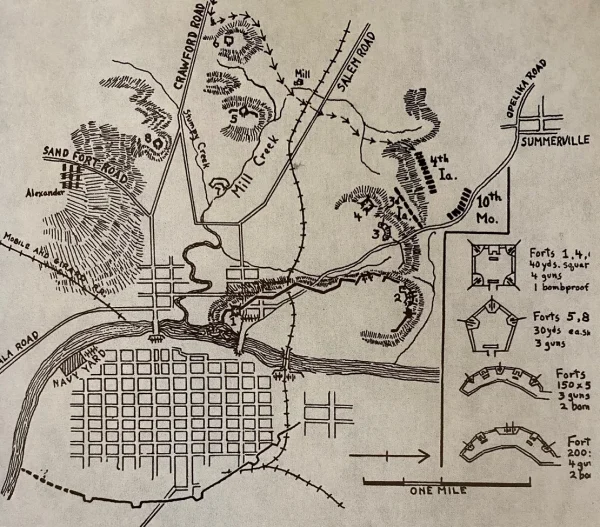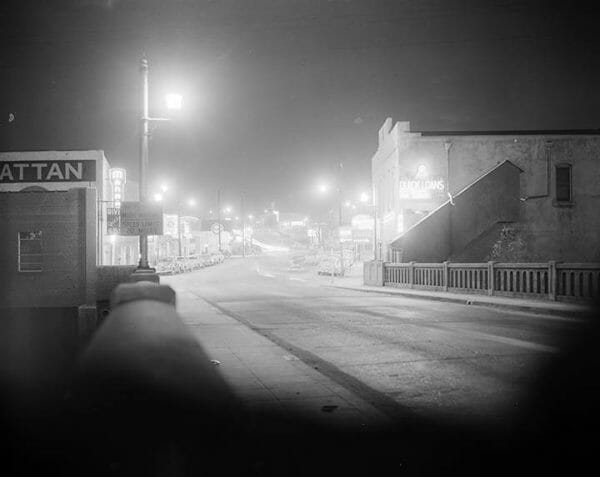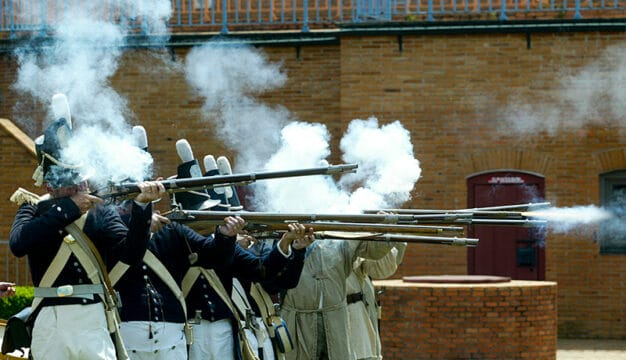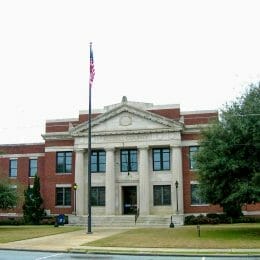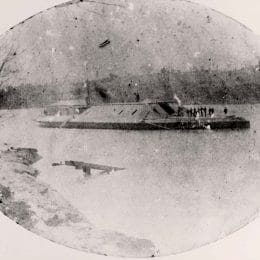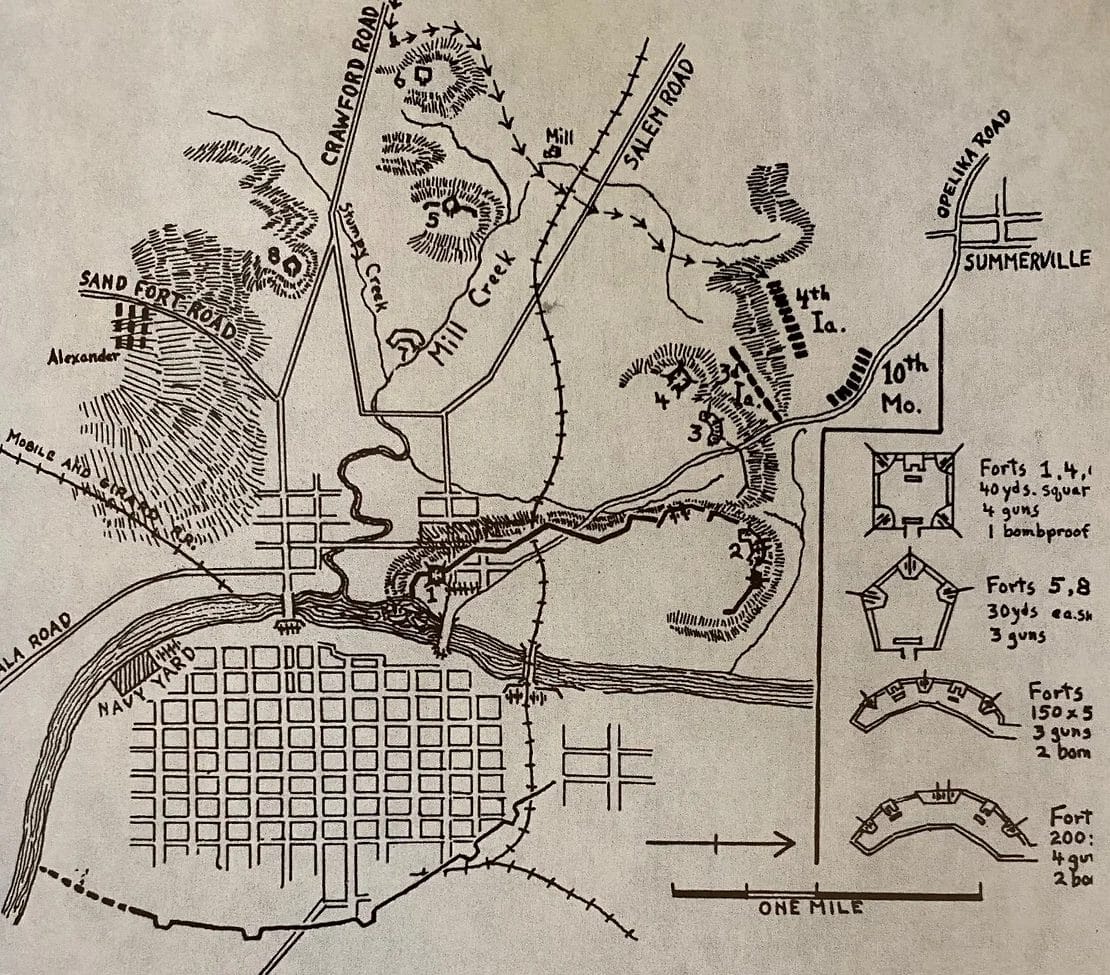Phenix City
Phenix City is the county seat of Russell County and is located in east Alabama along the west bank of the Chattahoochee River, which separates the city from Columbus, Georgia. Phenix City has a mayor-commission form of government, with each member serving for four years. At one time nationally known for its rampant crime and corruption, the city has evolved into Russell County’s largest metropolitan area. Olympian in track and field Harvey Glance was born in Phenix City.
 Russell County Courthouse
Phenix City has been the county seat of Russell County only since the early twentieth century. The town of Girard had this honor when the county was established in 1832, followed by Crawford in 1834, and then Seale in 1868. In 1926, Phenix City was established as a second county seat, with county administrative activities divided among the two towns. It was not until 1934 that Phenix City became the sole county seat of Russell County. Triandos Luke, who played in the National Football League for the Denver Broncos, was born in 1981 in Phenix City.
Russell County Courthouse
Phenix City has been the county seat of Russell County only since the early twentieth century. The town of Girard had this honor when the county was established in 1832, followed by Crawford in 1834, and then Seale in 1868. In 1926, Phenix City was established as a second county seat, with county administrative activities divided among the two towns. It was not until 1934 that Phenix City became the sole county seat of Russell County. Triandos Luke, who played in the National Football League for the Denver Broncos, was born in 1981 in Phenix City.
History
The region around what is now Phenix City originally was the territory of the Coweta branch of the Creek Indian nation. After the town of Columbus, Georgia, was established in 1828, traders and other individuals who preferred a less-regulated frontier culture gravitated to the Creek towns on the other side of the Chattahoochee River. Thus, Phenix City’s reputation as a wild and untamed place appears even in early references.
In spring 1865, during the Civil War, the town was attacked and subdued in an offensive by U.S. Army general James H. Wilson and his troops, who had also taken over Tuscaloosa, Selma, Montgomery, Girard, Columbus, and Macon. In occupying Girard, the federal forces had pushed the Confederates across the river into Columbus. Federal troops then crossed the river and took the city in what became known as the Battle of Columbus, one of the last battles in the Civil War.
The land that makes up present-day Phenix City was initially two towns. The southern town was named Girard, and the northern part was named Brownville. But in 1871, the U.S. Post Office confused the town of Brownville with another Brownville of earlier origin in Tuscaloosa County, and so the name Lively was chosen to replace Brownville. The reason for choosing this name is not known, but local lore indicates that the name referred to the lawless nature of the area. After a few years, the town once again became known as Brownville; confusion persisted about the town’s actual name, however, because the post office still maintained the name Lively, whereas the railroad depot in the town was called Knight’s Station.
On February 23, 1883, the Alabama Legislature officially incorporated the town of Brownville. On February 19, 1897, the legislature officially changed the name to Phenix City. Although no definitive source reveals why this name was chosen, possibilities include it being named after the Phenix Mills in Columbus, or perhaps after the phoenix, a bird that symbolized resurrection in Egyptian mythology.
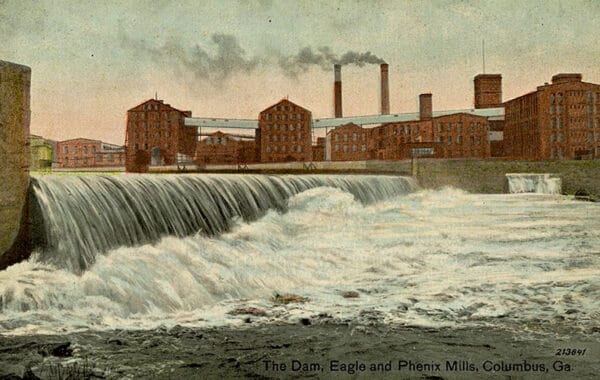 Eagle and Phenix Mills
Between 1880 and 1890, Dutch and German settlers established the Chattahoochee Brewery in Girard; the company retained the name after it moved to Columbus 20 years later. Early industries in the Phenix City area were based on forest products, agriculture products, and masonry products, and the town became known for its brickmaking. At one point, Phenix City also hosted the largest lithography plant in the South. After the Civil War, the area prospered from the brewery, water system, and textile mills. In 1882, as the result of poor drainage in Columbus, the Columbus Water Supply Company, a private venture, purchased 15 acres near Holland Creek in Alabama with the sole purpose of setting up a reservoir and providing water to Columbus through a pipeline. Later in 1916, the city of Columbus bought the facilities of the Columbus Water Supply Company and moved the system to Columbus under the name Columbus Waterworks. Also after the Civil War, W. H. Young founded the Eagle & Phenix, replacing his Eagle Factory, which had been burned by the U.S. Army. The mills brought in three shiploads of workers from England who were cheaper to employ than local American workers, with most of them living on the Alabama side of the river. Railroad companies also repaired rail lines to the area that had been destroyed in the war. In 1900, the Girard Cotton Mills, a subsidiary of Eagle & Phenix, was incorporated on the Alabama side of the river.
Eagle and Phenix Mills
Between 1880 and 1890, Dutch and German settlers established the Chattahoochee Brewery in Girard; the company retained the name after it moved to Columbus 20 years later. Early industries in the Phenix City area were based on forest products, agriculture products, and masonry products, and the town became known for its brickmaking. At one point, Phenix City also hosted the largest lithography plant in the South. After the Civil War, the area prospered from the brewery, water system, and textile mills. In 1882, as the result of poor drainage in Columbus, the Columbus Water Supply Company, a private venture, purchased 15 acres near Holland Creek in Alabama with the sole purpose of setting up a reservoir and providing water to Columbus through a pipeline. Later in 1916, the city of Columbus bought the facilities of the Columbus Water Supply Company and moved the system to Columbus under the name Columbus Waterworks. Also after the Civil War, W. H. Young founded the Eagle & Phenix, replacing his Eagle Factory, which had been burned by the U.S. Army. The mills brought in three shiploads of workers from England who were cheaper to employ than local American workers, with most of them living on the Alabama side of the river. Railroad companies also repaired rail lines to the area that had been destroyed in the war. In 1900, the Girard Cotton Mills, a subsidiary of Eagle & Phenix, was incorporated on the Alabama side of the river.
In 1922, Phenix City was part of both Lee and Russell Counties, but a boundary line change that same year located the city entirely within Russell County. The city of Girard merged into Phenix City on August 9, 1923, giving the newly enlarged town a combined population of 10,374. In 1932, Russell County ceded the Marvyn Community in the Northwest section of the county to Lee County in exchange for a portion of Phenix City in Lee.
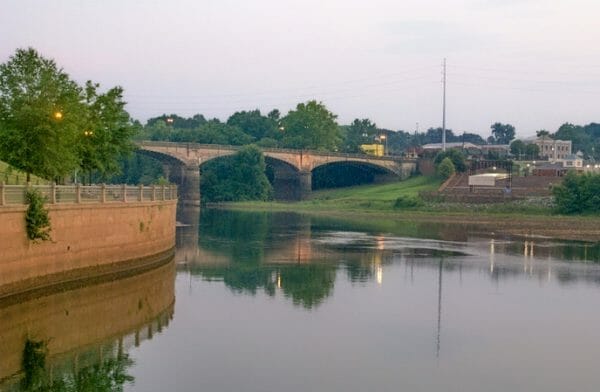 Chattahoochee River at Phenix City
During the Great Depression, Phenix City went bankrupt, accumulating more than $1.1 million of debt. By 1933, the city was operating under a federal receiver. At the time, local authorities rationalized widespread crime and corruption in Phenix City as being a necessary revenue producer in the absence of other businesses. City leaders took advantage of this activity and enforced a system of fines and licensing for gambling and for the use and sale of liquor to raise money for the city’s treasury, while not addressing the illegal activities themselves. By 1945, the city was collecting more than $228,000 a year in fines.
Chattahoochee River at Phenix City
During the Great Depression, Phenix City went bankrupt, accumulating more than $1.1 million of debt. By 1933, the city was operating under a federal receiver. At the time, local authorities rationalized widespread crime and corruption in Phenix City as being a necessary revenue producer in the absence of other businesses. City leaders took advantage of this activity and enforced a system of fines and licensing for gambling and for the use and sale of liquor to raise money for the city’s treasury, while not addressing the illegal activities themselves. By 1945, the city was collecting more than $228,000 a year in fines.
During World War II, Phenix City improved its police department with more men and equipment, and its first fire department was established in 1944. Four years later, the city welcomed its first city hospital, the Homer D. Cobb Memorial Hospital, named for the city’s mayor. The Phenix-Girard Journal, now defunct, was the most widely read newspaper in the area at this time. Also during the 1940s, Phenix City increasingly came under the control of organized crime bosses who ran gambling, narcotics, and prostitution operations throughout the city. These men rigged local and state elections and held important leadership positions in the chamber of commerce, on school and hospital boards, and in several service organizations. Local law enforcement and city officials were members of the Ku Klux Klan.
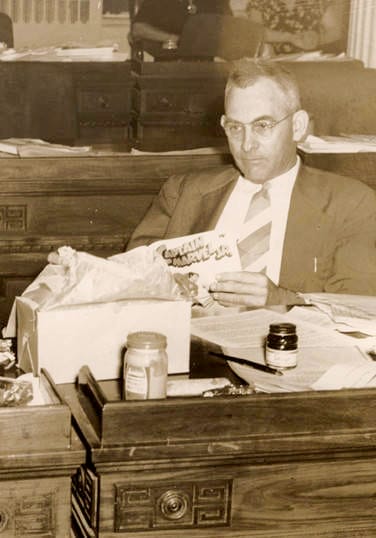 Albert Patterson
Concerned citizens began to try to clean up the illegal activities in the city but were met with violent resistance from the gambling interests. Hugh Bentley, a local businessman and Sunday school teacher, organized a group to clean up the city and had his house bombed as a result. Local attorney Albert Patterson, who had moved his family to the city in 1933 because of its booming economy, despite its reputation, joined with Bentley and the Russell Betterment Association (RBA), whose purpose was to fight corruption in Russell County, specifically in Phenix City. Deciding that the best way to clean up the city was to win the state attorney general‘s office and thus bring the power of that office to bear upon the problem, the group put Patterson forward for the office, and he won the Democratic primary, despite attempted election tampering by local officials. But on June 18, 1954, Albert Patterson was assassinated outside of his law office.
Albert Patterson
Concerned citizens began to try to clean up the illegal activities in the city but were met with violent resistance from the gambling interests. Hugh Bentley, a local businessman and Sunday school teacher, organized a group to clean up the city and had his house bombed as a result. Local attorney Albert Patterson, who had moved his family to the city in 1933 because of its booming economy, despite its reputation, joined with Bentley and the Russell Betterment Association (RBA), whose purpose was to fight corruption in Russell County, specifically in Phenix City. Deciding that the best way to clean up the city was to win the state attorney general‘s office and thus bring the power of that office to bear upon the problem, the group put Patterson forward for the office, and he won the Democratic primary, despite attempted election tampering by local officials. But on June 18, 1954, Albert Patterson was assassinated outside of his law office.
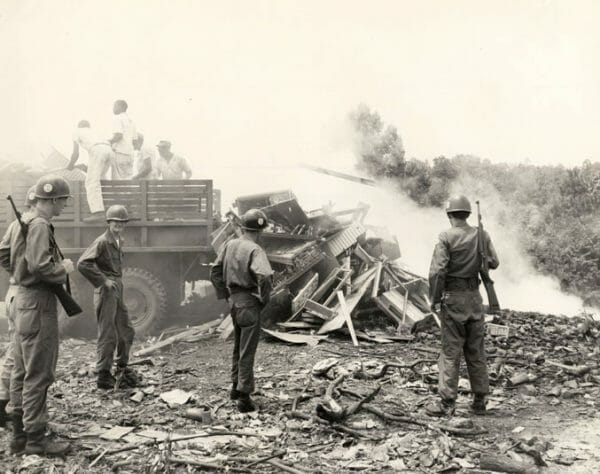 National Guardsmen in Phenix City
In response to Patterson’s murder, Phenix City Mayor Cobb ordered all businesses where alcohol was sold to close on Sundays. On the state level, Gov. Seth Gordon Persons placed the town under martial law and sent in 75 National Guardsmen under the command of World War II veteran Gen. Walter J. Hanna. The Guardsmen performed around-the-clock raids on nightclubs, warehouses, and gambling institutions, and nearby Fort Benning (now Fort Moore) declared Phenix City off limits to its soldiers. After learning about his father’s death, future governor John Patterson ran for the state attorney general position in 1955; while in that office, he prosecuted those who were responsible for his father’s murder (though only one man was actually convicted). In 1955, Allied Arts produced the film The Phenix City Story, which was a wildly exaggerated treatment of the Patterson murder and the surrounding corruption. After the clean-up, Look magazine named Phenix City as an All-American City in 1955, and in 2007 BusinessWeek named it the nation’s Best Affordable Suburb for raising a family.
National Guardsmen in Phenix City
In response to Patterson’s murder, Phenix City Mayor Cobb ordered all businesses where alcohol was sold to close on Sundays. On the state level, Gov. Seth Gordon Persons placed the town under martial law and sent in 75 National Guardsmen under the command of World War II veteran Gen. Walter J. Hanna. The Guardsmen performed around-the-clock raids on nightclubs, warehouses, and gambling institutions, and nearby Fort Benning (now Fort Moore) declared Phenix City off limits to its soldiers. After learning about his father’s death, future governor John Patterson ran for the state attorney general position in 1955; while in that office, he prosecuted those who were responsible for his father’s murder (though only one man was actually convicted). In 1955, Allied Arts produced the film The Phenix City Story, which was a wildly exaggerated treatment of the Patterson murder and the surrounding corruption. After the clean-up, Look magazine named Phenix City as an All-American City in 1955, and in 2007 BusinessWeek named it the nation’s Best Affordable Suburb for raising a family.
Demographics
According to 2020 Census estimates, Phenix City recorded a population of 36,461. Of that number, 46.9 percent identified themselves as African American, 45.3 percent as white, 5.0 percent as Hispanic, 2.7 percent as two or more races, 1.4 percent as Asian, 0.2 percent as American Indian and Alaska Native, and 0.2 percent as Native Hawaiian or Other Pacific Islander. The city’s median household income was $41,842, and per capita income was $25,512.
Employment
According to 2020 Census estimates, the workforce in Phenix City was divided among the following industrial categories:
- Educational services, and health care and social assistance (22.1 percent)
- Retail trade (15.5 percent)
- Manufacturing (13.1 percent)
- Finance, insurance, and real estate, rental, and leasing (11.0 percent)
- Arts, entertainment, recreation, accommodation, and food services (9.0 percent)
- Professional, scientific, management, and administrative and waste management services (8.8 percent)
- Public administration (6.7 percent)
- Construction (4.8 percent)
- Transportation and warehousing and utilities (4.4 percent)
- Other services, except public administration (2.7 percent)
- Wholesale trade (1.0 percent)
- Information (0.7 percent)
- Agriculture, forestry, fishing and hunting, and extractive (0.2 percent)
Education
The Phenix City School System has six elementary schools, one middle school, one intermediate school, and one high school. It hosts Chattahoochee Valley Community College, which offers two-year degree programs, and has a Troy University campus as well.
Transportation
Three U.S. highways run through Phenix City: U.S. 80 runs from Savannah, Georgia, to San Diego, California, U.S. 431 runs between the Midwest and Florida, and U.S. 280 runs from Blichton, Georgia, to Birmingham.
Five bridges connect Phenix City to Columbus: Dillingham Street, completed in 1912; 14th Street, built in 1921; Oglethorpe, opened in 1963; Thirteenth Street, opened in 2000; and North Bypass, which connects Alabama with the Manchester expressway in Columbus and ties in with the Interstate I-85 connector.
Events and Places of Interest
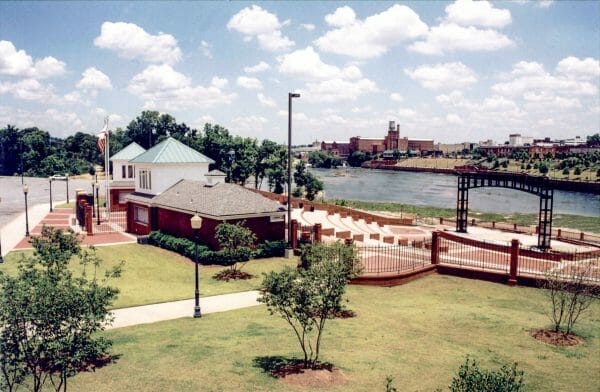 Phenix City Amphitheater
In front of the Phenix City Municipal Building there is a statue of a phoenix rising from the column on which it sits, symbolizing hope and renewal. It was dedicated on July 4, 1976. Phenix City celebrated its 100th anniversary with the construction of Centennial Park (1883-1983) as part of its riverfront development. The city also features a river walk designated as a national recreation trail and an amphitheater.
Phenix City Amphitheater
In front of the Phenix City Municipal Building there is a statue of a phoenix rising from the column on which it sits, symbolizing hope and renewal. It was dedicated on July 4, 1976. Phenix City celebrated its 100th anniversary with the construction of Centennial Park (1883-1983) as part of its riverfront development. The city also features a river walk designated as a national recreation trail and an amphitheater.
Phenix City hosts a Twin Cities Classic Horse Show, a rodeo, a Festival of Lights on the Riverwalk, a Bi-City Christmas Parade, and a Festival of Art at the Log Cabin, featuring the works of local artists.
Videos
Further Reading
- Howard, Gene L. Patterson for Alabama: The Life and Career of John Patterson. Tuscaloosa: University of Alabama Press, 2008.
- Russell County Heritage Book Committee. The Heritage of Russell County, Alabama. Clanton, Ala.: Heritage Publishing Consultants, 2003.
- Trest, Warren A. Nobody But the People: The Life and Times of Alabama’s Youngest Governor. Montgomery, Ala.: NewSouth Books, 2008.
